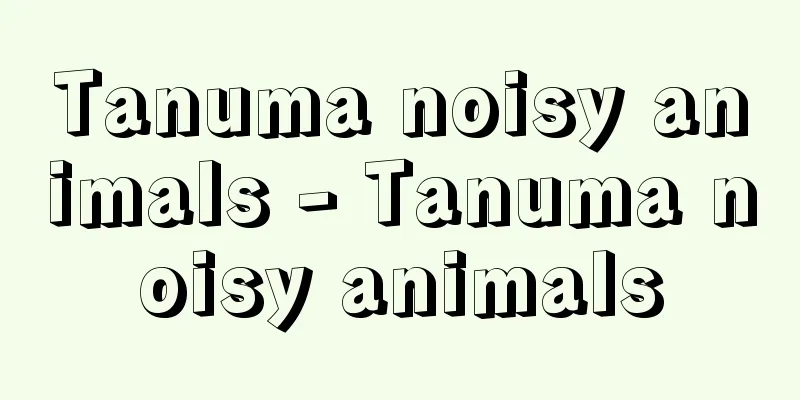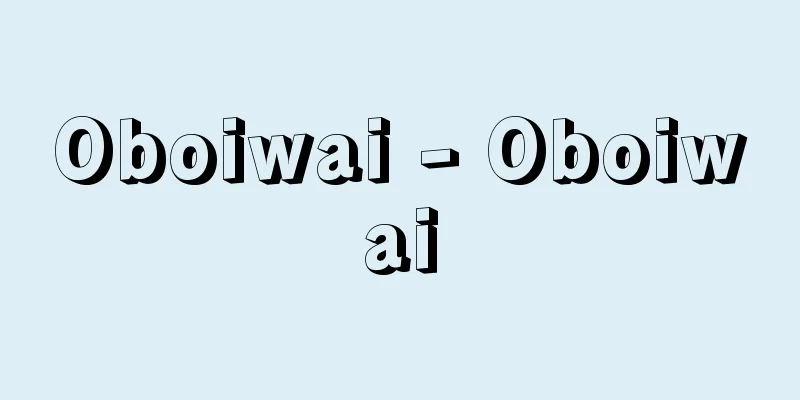Buson

|
A haiku poet and painter from the mid-modern period. His original surname was Taniguchi. He began to use the Yosa/Yoza name after returning to Kyoto from Tango. His haiku names were initially Saicho and Saicho, and his Buson name first appeared in the New Year's Journal in 1744 (Kanpo 4). His most well-known artist names were Shachokou, Shashunsei, and after 1778 (An'ei 7), Shain. [Takayuki Shimizu] Origins and trainingHe was born in the first year of the Kyoho era into a wealthy farming family in Kemamura Village, Higashinari County, Settsu Province (Kemacho, Miyakojima Ward, Osaka City). During his childhood, he had some contact with an artist named Korenobu, but towards the end of the Kyoho era (1716-1736), he went to Edo on his own to study calligraphy, painting, Chinese poetry, haiku, etc. After 1737 (Genbun 2), he became a student of Yahantei, a poet by Hayano Hajin (Sōa), who had returned to Edo from Kyoto, and became known in the Edo haiku world. In 1742 (Kanpo 2), after the death of his teacher Soa, he left Edo and went to Yuki (Yuki City, Ibaraki Prefecture) relying on Isao Gantou, and eventually attempted to travel from Matsushima and Kisakata to the whole of Oshu. In 1744, he published his first New Year's Day book in Utsunomiya, and was the first to use the pen name "Buson". The following year, in 1745 (Enkyo 2), he wrote "To mourn Hokujurosen o o muru" (I mourn for Hokujurosen) (signed Shaku Buson) in mourning the death of Hayami Shinga of Yuki. It is a refreshing free verse work that criticizes the popularity of kana poetry (Japanese poetry). It is believed that he converted to Daigen Shonin of Gugyo-ji Temple in Yuki and shaved his head, and left behind many sliding door paintings at the temple. Not only genre paintings in the style of Hanabusaitchō, but also an inclination towards emerging literati paintings that sought to express spiritual freedom can be seen. [Takayuki Shimizu] Return to the westIn August 1751 (1st year of the Horeki era) at the age of 36, he went to Kyoto. Among his students were Mochizuki Souoku, a surviving brother of Soa, and Takai Kikei, but Buson's goal was to study the emerging literati painters such as Sakaki Hyakusen and Ikeno Taiga. In 1754, he went to Miyazu in Tango and devoted himself to painting for three and a half years, studying Chinese editions such as "Eight Types of Paintings" and "Kaishien Gaden" and revising and deepening his studies by studying nature itself, thereby acquiring the skills of a professional painter. He placed more emphasis on Chinese painting style than Japanese painting, and painted many landscapes and gods. After returning to Kyoto, he changed his surname to Yosa, married, and had a daughter. He also adopted the realistic style of Shen Nanpin, a Chinese painter from the imported Qing dynasty, and in 1763 he painted large folding screens including a landscape painting and a painting of wild horses, which earned him high praise in the Kyoto art world. [Takayuki Shimizu] The parallel period of painting and haiku During the Meiwa period (1764-1772), Buson's career as an artist flourished, and he produced a succession of large works through his folding screen studies. During this time, from 1766 to 1768 (Meiwa 3-5), he traveled to Sanuki (Kagawa Prefecture) and acquired a keen sense of movement in his excellent ink paintings. In 1771, he competed with Ike Taiga in the production of the "Jubenjugi Gasatsu" (The Ten Benefits and Ten Preference Paintings), and became active as one of the masters of modern Southern painting. Along with Sumi Taigi, Buson was listed as a promising haiku poet who had come down from Edo in the "Haikaikosen" (1763), edited by Miyake Shozan, and on returning to Tokyo from Sanuki, he devoted himself enthusiastically to the hokkukai (poetry gatherings) held at Sankasha, In March 1770, he succeeded Yabantei II on the condition that his senior, Kikei's son, Kitou, be his successor, and published "Meiwa Shinbou no Haru" the following year. Kiou, a gentle and loyal disciple, handled the complicated affairs of Yabantei with precision from the An'ei period (1772-1781) onwards. Starting with "Sono Yukikage" (1772), the two collections "Akegarasu" (1773) and "Zoku Akegarasu" (1776) showed the world the results of the restoration movement led by the Jokyo Shofu school of Buson. Yaban'o, in his role as guardian, left the task of selecting the anthology to Kito, with the intention of encouraging his disciple's independence, while Buson himself prioritized his awareness as a Southern School artist. In the haiku world, he was notable for his interactions with Bakusui and Ranko from Kanazawa, Chora from Ise, Kyotai from Nagoya, and Furukuni (Oemaru) and Jiryu from Osaka, and there was a great deal of activity with haiku poets from all over the country who were reviving the school and traveled to Kyoto to see Buson and Kito as their teacher and disciple. His interactions with Chora, Kyotai, and Bakusui were particularly important. His paintings were not only sold to his students in Kyoto, but also to other regions through his friends and acquaintances in the haiku world. [Takayuki Shimizu] The era of fusion of art and haikuIn 1776 (An'ei 5), Higuchi Doryu initiated the founding of a twice-yearly sutra copying society at Konpukuji Temple in the eastern part of Kyoto, and a series of Basho honouring events, symbolising the restorationist movement of a group that idealised seclusion. The Danrinkai of 1779 was a haiku school for the study of linked verse, from which he and Kito produced the 'Mosmo' poetry anthology, but the climax of his later years was in 1777. At the end of the previous year, he had married off his only daughter, and he edited 'Yahanraku' and published the nostalgic series 'Shunpubatei no Kyoku', leaving an enduring legacy in the history of literature. From April 8th, he began composing about 10 verses a day as a summer ritual to commemorate his late mother, but he discontinued it due to the issue of his daughter's divorce. These verses are not realistic, but rather show the distinctive feature of his style, which pursues ideal beauty. The rain clouds are not even at bay, even though it's a hundred miles away. At Miidera Temple, the sun is approaching midday. The young maples After reaching its peak in 1777, Buson's literary activities declined. His style shows no change even in Gosha Hogo, an anthology of poems to commemorate the thirteenth anniversary of Shoha's death, compiled by Korekoma in 1783 (Tenmei 3). In terms of his painting, in a letter to Kito in 1776 he boasted of his "dramatic sketches," and between 1777 and 1779 he produced many portraits of Basho, including Nozarashi Kikou Zukan and Oku no Hosomichi Zukan, in an attempt to fuse painting and haiku. His pen name "Xie Yin" from 1778 and his signature, which further included "Nihon Tosei," are related to the creation of a unique Nanga style rooted in the Japanese climate. His 1782 works "Landscapes of the Four Seasons" and "Farmer's Horses" show a remarkable regional flavor and haiku style that is different from that of Ike no Taiga, and masterpieces such as "Retreating to the Bamboo Valley" and "Colored Towers at Night," both of which are from unknown years, show an originality and perfection that no one other than Buson could have painted. [Takayuki Shimizu] Later yearsHis final haiku activity was in 1783, in spring, when he co-sponsored with Ryota of Edo the Torikoshi Kogyo (actually the 90th anniversary of Basho's death) organized by Kyodai at Gichu-ji Temple and Higashiyama. The passion Buson showed at this time makes it clear that his lifelong haiku activities were related to the historical significance of the Basho-style restoration movement itself. He fell ill in the early winter of 1783 and passed away at the early dawn of December 25th at the age of 68, a complete life. The circumstances of his final days are detailed in Kito's "Yahan-o Shuenki" (Record of the End of the Night), the opening volume of the memorial collection "Karahiba" (1784). His last poem was "All nights are bright on the white plum blossoms." In accordance with his last wishes, he was buried beside Basho-an in Konpuku-ji Temple (Ichijoji Saigata-cho, Sakyo-ku, Kyoto City), and his wife and daughter were supported by Kito, Gekkei, Baitei, and wealthy merchants Denpuku and Hyakuchi. The Buson Collection of Haiku (1784), which is credited with being "written by Kito," was previously understood to have been compiled by Kito, but the appearance of Buson's autographed haiku notebook (owned by Homma Museum of Art) in his later years revealed that it was a collection of haiku that Buson had personally selected in his final years. Following his teacher's wishes, Kito faithfully copied the originals and published them for the world to see. [Takayuki Shimizu] "Otani Atsuzo et al., eds., Classical Haiku Literature Series 12: Buson Collection (1972, Shueisha)" ▽ "Ogata Gen, ed., Buson's Autographed Haiku Book (1974, Chikuma Shobo)" ▽ "Buson and his disciples" (Inbara Taizo Works Collection 13, 1979, Chuokoron-Shinsha)" ▽ "Shimizu Takayuki, annotated, Shincho Japanese Classical Literature: Yosa Buson Collection (1979, Shinchosha)" ▽ "Yoshizawa Tadashi, commentary, Japanese Art Painting Collection 19: Yosa Buson (1980, Shueisha)" ▽ "Muramatsu Toji, Appreciation of Japanese Classics 17: Buson Collection (1981, Shogaku Tosho)" ▽ "Shimizu Takayuki, Appreciation and Criticism of Yosa Buson (1983, Meiji Shoin)" ▽ "Complete Translation of Japanese Classics: Buson and Issa" (1983, Shogakukan) edited and translated by Riichi Kuriyama et al. [Reference items] | | |"Portrait Collection" Manuscript held at the National Diet Library Buson Written by Buson, illustrated by Matsumura Gekkei . National Diet Library collection . "New Flower Picking" ("New Flower Picking") Source: Shogakukan Encyclopedia Nipponica About Encyclopedia Nipponica Information | Legend |
|
近世中期の俳人、画家。本姓谷口氏。与謝(よさ/よざ)氏を称するのは丹後(たんご)から帰洛(きらく)以後のこと。俳号は初め宰町(さいちょう)・宰鳥、蕪村号の初出は寛保(かんぽう)4年(1744)『歳旦帖(さいたんちょう)』からである。代表的画号は謝長庚(しゃちょうこう)、謝春星(しゃしゅんせい)、1778年(安永7)以後は謝寅(しゃいん)。 [清水孝之] 出自と修業時代享保(きょうほう)元年摂津国(せっつのくに)東成(ひがしなり)郡毛馬(けま)村(大阪市都島区毛馬町)の豊かな農家に生まれたらしい。少年時代に伊信(これのぶ)という画生と多少の交流があったが、享保(1716~1736)の末ごろ単身江戸へ下り書画、漢詩、俳諧(はいかい)などを学んだ。1737年(元文2)以後は京都から江戸に帰った早野巴人(はじん)(宋阿(そうあ))の夜半亭(やはんてい)に入門して江戸俳壇に知られた。1742年(寛保2)恩師宋阿没後江戸を離れ、砂岡雁宕(いさおかがんとう)を頼って結城(ゆうき)(茨城県結城市)に行き、やがて松島、象潟(きさかた)から奥羽一円に及ぶ旅行を試みた。1744年には宇都宮(うつのみや)で初の歳旦帖を刊行、初めて「蕪村」号を用いた。翌1745年(延享2)結城の早見晋我(しんが)の死を悼んで『北寿老仙をいたむ』(釈蕪村と署名)を残した。仮名詩(和詩)の流行を批判した清新な自由詩である。結城弘経寺(ぐぎょうじ)の大玄上人(しょうにん)に帰依(きえ)して剃髪(ていはつ)したと推定され、同寺に多数の襖絵(ふすまえ)を残した。英一蝶(はなぶさいっちょう)風の風俗画のみならず、精神の自由を表現しようとする新興文人画への志向が認められる。 [清水孝之] 西帰1751年(宝暦1)36歳の8月に京都に上る。宋阿の遺弟望月宋屋(もちづきそうおく)、高井几圭(たかいきけい)らがいたが、蕪村の目的は彭城百川(さかきひゃくせん)、池大雅(いけのたいが)らの活躍する新興文人画研究に存した。1754年には丹後・宮津に赴き3年半の間専心画業に精励し『八種画譜』『芥子園画伝(かいしえんがでん)』など中国版本の学習を、自然そのものに学ぶことによって修正深化し、専門画家としての実力を身につけた。和画よりもいっそう漢画風に重点を置き、山水図、神仙図などを多く描いた。帰洛後姓を与謝氏と改め、結婚して1女をもうけた。また来舶清人(しんじん)沈南蘋(しんなんぴん)の写実的画風を取り入れ、1763年には山水図、野馬図などの屏風(びょうぶ)大作を描いて京洛画壇に高く評価される。 [清水孝之] 画俳併行時代明和(めいわ)年間(1764~1772)に入ると画業に脂がのり、屏風講によって続々と大作が制作された。その間1766~1768年(明和3~5)に讃岐(さぬき)(香川県)へ渡り優れた墨彩に気韻生動を会得し、やがて1771年池大雅とともに『十便十宜画冊(じゅうべんじゅうぎがさつ)』を競作し近世南画大成者の一人として活躍する。三宅嘯山(みやけしょうざん)編『俳諧古選』(1763)に炭太祇(たんたいぎ)とともに江戸下りの俳人として期待された蕪村は、讃岐から帰京すると三菓社の発句会(ほっくかい)に熱意を傾け、 1770年3月、先輩几圭の息几董(きとう)を後継者とすることを条件に夜半亭2世を継承、翌年『明和辛卯春(しんぼうのはる)』を刊行する。温厚忠実な弟子几董は安永(1772~1781)以後、夜半亭の煩雑な事務を的確に処理してゆく。『其雪影(そのゆきかげ)』(1772)を手始めに『あけ烏』(1773)、『続明鴉(あけがらす)』(1776)両集は蕪村一派の貞享蕉風(じょうきょうしょうふう)による復古運動の成果を天下に示した。夜半翁が後見者の立場で撰集(せんしゅう)を几董任せにしたのは、弟子の自立性を促す意図であり、蕪村自身は南宗画人としての意識が優先していた。俳壇的には金沢の麦水(ばくすい)・闌更(らんこう)、伊勢(いせ)の樗良(ちょら)、名古屋の暁台(きょうたい)、大坂の旧国(ふるくに)(大江丸)・二柳(じりゅう)らとの交渉が目だち、諸国の中興俳人たちが蕪村・几董師弟を目ざして上洛するという盛況であった。とくに樗良・暁台・麦水との交流は重要である。画業も京都の門人たちのみでなく、俳諧関係の知友らを通じて地方へも販路を広げていった。 [清水孝之] 画俳融合時代1776年(安永5)樋口道立(ひぐちどうりゅう)の首唱により洛東金福寺(こんぷくじ)を会場とする、年2回の写経社の結成と一連の芭蕉(ばしょう)顕彰事業も、隠逸を理想とする一派の復古運動を象徴する。1779年の檀林会(だんりんかい)は連句修業の俳諧学校、そこから几董との両吟歌仙『もゝすもゝ』が実を結ぶが、晩年の最高潮期は1777年である。前年末ひとり娘を嫁がせた彼は『夜半楽(やはんらく)』を編集して郷愁の連作詩「春風馬堤曲(しゅんぷうばていのきょく)」を発表し文学史上不朽の業績を残した。ついで4月8日から亡母追善の夏行(げぎょう)として毎日10句ほどの夏発句(げほっく)を始めるが、娘の離縁問題によって中絶する。それらの句は写実ではなく、理想美を追求する作風の特色をよく示している。 方百里雨雲よせぬぼたむ哉 1777年を頂点として蕪村の文学活動は下降する。1783年(天明3)の維駒(これこま)編召波十三回忌集『五車反古(ごしゃほうご)』においても作風に変化をみせることはない。画業では1776年几董あて書簡に「はいかい物の草画」を誇負し、1777~1779年には『野ざらし紀行図巻』『奥の細道図巻』や芭蕉翁像を多く制作して画俳の融合を試みる。1778年からの「謝寅」号やさらに「日本東成(とうせい)」を加えた落款は、日本的風土に根ざした独自の南画の創造とかかわる。1782年の『四季山水図』『農家飼馬図』には池大雅とは異質の風土性と俳諧味が著しく、年次不明の『竹渓訪隠図』『夜色楼台図』などの傑作は蕪村以外の誰人も描けない独自性と完成度を示している。 [清水孝之] 晩年最後の俳壇的活動は、1783年春義仲寺(ぎちゅうじ)と東山を舞台にした暁台主催の芭蕉百回忌取越興行(とりこしこうぎょう)(実は九十回忌)を、江戸の蓼太(りょうた)とともに後援したことである。このとき蕪村の示した情熱は、彼の生涯にわたる俳諧活動が、蕉風復古運動そのものの歴史的意義にかかわることを明示する。1783年初冬より病に倒れ12月25日未明68歳の完結した生涯を終わった。終命のありさまは追善集『から檜葉(ひば)』(1784)巻頭の几董筆「夜半翁終焉記(しゅうえんき)」に詳しい。 しら梅に明る夜ばかりとなりにけり [清水孝之] 『大谷篤蔵他編『古典俳文学大系12 蕪村集』(1972・集英社)』▽『尾形仂編著『蕪村自筆句帳』(1974・筑摩書房)』▽『『蕪村と門人』(『潁原退蔵著作集13』1979・中央公論社)』▽『清水孝之校注『新潮日本古典文学 与謝蕪村集』(1979・新潮社)』▽『吉沢忠解説『日本美術絵画全集19 与謝蕪村』(1980・集英社)』▽『村松友次著『鑑賞日本の古典17 蕪村集』(1981・尚学図書)』▽『清水孝之著『与謝蕪村の鑑賞と批評』(1983・明治書院)』▽『栗山理一他校注・訳『完訳日本の古典 蕪村集・一茶集』(1983・小学館)』 [参照項目] | | |『肖像集』 写本国立国会図書館所蔵"> 蕪村 蕪村著 松村月渓画国立国会図書館所蔵"> 『新花つみ』(『新華摘』) 出典 小学館 日本大百科全書(ニッポニカ)日本大百科全書(ニッポニカ)について 情報 | 凡例 |
>>: Tomb of Prince Fuso-Wai-Kun-Bo (English: Pujoyegun-myo)
Recommend
visual angle
…The unit of visual acuity is determined by inter...
Vladimir Highway - Vladimir Highway
…Vladimir then existed merely as a provincial cit...
Anthurium - Anthurium
A foliage plant of the Araceae family (APG classi...
Pinus monticola (English spelling) Pinus monticola
… [Makoto Nishida]. … *Some of the terminology th...
Wadsworth, EA (English spelling) WadsworthEA
…The name “Bauticism” was coined by the poet E. P...
Royalists
The supporters of the King in the Puritan Revolut...
Hanson, D.
…It was produced mainly in the United States and ...
Isabella d'Este - Isabella d'Este
…He also employed A. Mantegna as his court painte...
Canik
…In Turkey, this name is not used, and each mount...
Railway Promotion Association - Tetsudoukosaikai
This foundation was established in February 1932 ...
Online system - online system
It refers to a method of processing information d...
All things - Kaigu
〘noun〙 The state of having a complete set of somet...
Yuki Tokunaga
Social worker. Born in Shinjuku, Tokyo. Baptized a...
Don't eat dogs - Inukuwazu
...This is because it was believed that dogs are ...
Willie Nelson - Willie Nelson
...popular music with a primary audience of white...


![Suki [Village] - I like it](/upload/images/67cbf32ca4307.webp)






